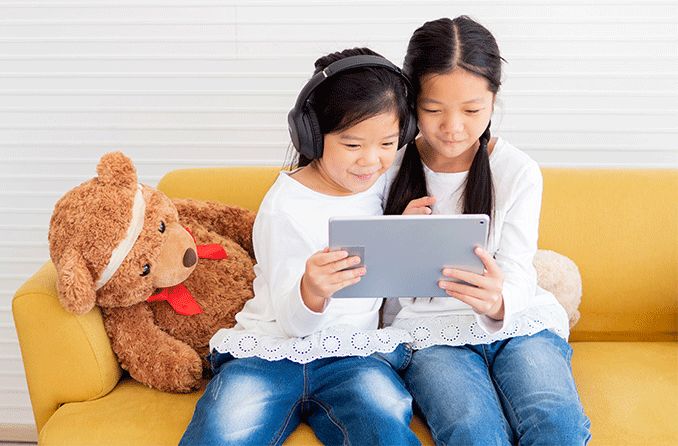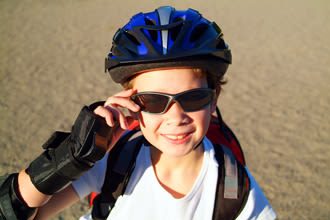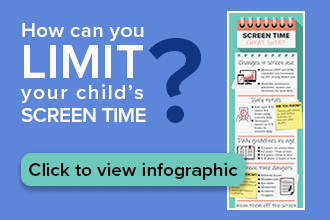Is too much screen time bad for kids?

Schedule an exam
Find Eye DoctorYou check in to say good night to your son only to find he is playing "Fortnite" in bed.
Or your daughter is busy texting when she is supposed to be studying.
Children and their phones are inseparable today, and all that reading and playing games on their handheld devices may be harming their vision.
To reduce screen time, some parents ban phones at the dinner table. This applies to both adults and children. And in some homes, playing games or texting must stop two hours before bedtime.
To put a hard stop on screen time, some moms and dads set time limits on their children's daily device use. For example, when a total of two hours of screen time has been reached, no more texting, game playing or YouTube watching.
Definition of "screen time"

According to The Vision Council, 72 percent of American parents report their children routinely engage in more than two hours of screen time per day. And it's very likely most kids actually spend significantly more time staring at screens than their parents think they do.
As kids grow, their screen time tends to grow with them. And even very young children these days are spending a significant amount of time each day staring at screens. According to Common Sense Media, young children in the U.S. spend the following amount of time each day using digital devices:
Kids under 2 years of age: 42 minutes per day
Kids ages 2 to 4: 2.5 hours per day
Children ages 5 to 8: nearly 3 hours per day
Why might too much screen time be a problem for kids?
The Vision Council says 30 percent of parents report their children experience at least one of the following symptoms after being exposed to more than two hours of screen time per day:
Headaches
Neck/shoulder pain
Eye strain, dry or irritated eyes
Reduced attention span
Poor behavior
Irritability
Any of these symptoms could potentially affect academic performance and social interactions.
The rapid rise of myopia, or nearsightedness, worldwide has been linked to increased use of and exposure to electronic devices.
In Singapore, for example, 65 percent of students in Primary 6 are myopic. In the United States and Europe, where myopia rates traditionally have been lower, around half of young adults now suffer from myopia compared with 25 percent in the 1970s.
READ NEXT: Screen time recommendations by age
The impact of blue light
The LED screens of computers and portable digital devices emit a broad spectrum of visible light. These light rays include a variety of different wavelengths, including a type of high-energy visible light called "blue light."
Blue light has shorter wavelengths and higher energy than other visible light rays, and most exposure comes from the sun, even indoors.
Blue-turquoise light plays an important role in regulating our body's circadian rhythm. This basically is an internal clock that's running in our brain and cycles between alertness and sleepiness at regular intervals over a 24-hour period. It's also called our sleep/wake cycle.
Too much exposure to this blue light at the wrong time of day can disrupt a person's sleep/wake cycle. Due to this, it is helpful to ensure that your child is not on their digital device too close to bedtime.
SEE RELATED: What are blue light glasses? Do you need them?
Strategies that benefit eye health
So then, what can a parent do to prevent too much screen time and help ensure eye health?
It's unlikely kids will reduce their use of digital devices. So the answer lies in taking steps to limit the amount of time they are spending on their devices and teaching them strategies that benefit their eye health.
Too much time looking at screens may cause some visual discomfort. To address this, practice the 20-20-20 rule: Every 20 minutes, look at something 20 feet away for 20 seconds.
If decreasing screen time is not an option, it may be worthwhile to look into computer glasses. These glasses make it easier to focus on the screen, which can improve long-term viewing comfort. Some computer glasses also have a blue light filter.
Appropriate eyeglasses and sunglasses

The sun emits much more blue light than digital devices. All children should wear sunglasses outdoors to reduce their exposure to harmful blue light.
All children should wear sunglasses outdoors to reduce exposure to ultraviolet (UV) light.
If your child wears glasses, one solution is to purchase eyeglasses with lenses that reduce the amount of UV light that enters the eyes. A number of lens manufacturers produce eyeglass lenses that can do this.
Another option is to have an anti-reflective coating applied to the lenses.
A third option is to purchase glasses with photochromic lenses. These sun-sensitive lenses have the added advantage of automatically blocking UV light outdoors without the need for a separate pair of prescription sunglasses.
Yet another option is a pair of polarized sunglasses for outdoor wear.
Screen filters
But what if your child doesn't need prescription glasses?
The most convenient option in this case is to purchase a screen filter that can be applied to the surface of your child's digital devices. These filters can help reduce glare and increase visual comfort.
Also, remember to use the blue light filtering features on certain devices (like Apple's Night Shift), or multi-platform apps that block blue light, such as f.lux and Iris.
Set limits on screen time
To reduce the risk of your child disrupting his or her sleep/wake cycle, create a "no-screens" rule at least an hour or two before their scheduled bedtime.
Or set a time limit on your child's phone use. Apple, Google and other tech companies have recently introduced time management features and apps that allow you to monitor your child's daily screen time. Visit your phone vendor's website or store to learn more.
Be proactive as a parent. One goal maybe? Spend more quality time together and less screen time with your son or daughter left to their own devices.
There are many strategies to implement screen time limits and encourage good visual habits while they're watching YouTube videos, posting Snaps and playing games.
Finally, schedule annual eye exams with an eye doctor near you to monitor your child’s vision and eye health. And don't forget to ask your eye doctor about the most appropriate lens options to help ensure your child’s visual comfort during screen time.
READ NEXT: Tips to reduce your child's risk of computer vision problems
The 2017 Common Sense Census. Common Sense Media. Accessed December 2018.
How to use Apple's new screen time and app limits features in iOS 12. The Verge. September 2018.
Digital eye strain. The Vision Council. Accessed July 2018.
Association of digital media use with subsequent symptoms of attention-deficit/hyperactivity disorder among adolescents. JAMA. July 2018.
Association of disrupted circadian rhythmicity with mood disorders, subjective well-being, and cognitive function: a cross-sectional study of 91,105 participants from the UK Biobank. The Lancet Psychiatry. June 2018.
Google rolls out app time management controls. TechCrunch. May 2018.
Circadian rhythms in diet-induced obesity. Advances in Experimental Medicine and Biology. September 2017.
Myopia increasing worldwide. The Straits Times. August 2017.
Prevention of increased abnormal fundus autofluorescence with blue light-filtering intraocular lenses. Journal of Cataract & Refractive Surgery. September 2015.
Page published on Wednesday, February 27, 2019
Page updated on Tuesday, February 20, 2024








